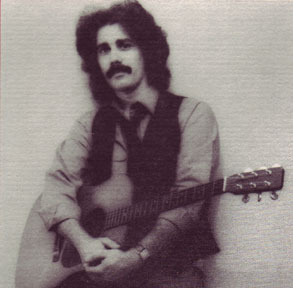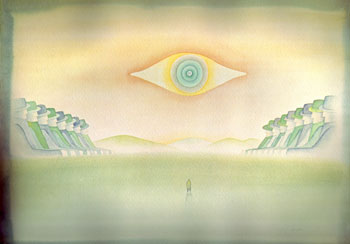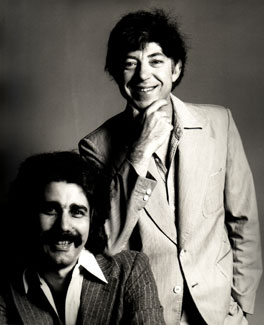

|
Soundclip:
|
| See Steve's Hand-Written Lead
Sheet |
|
Steve
Khan's
lead
sheet :  In performance, while recording the tune, the core group of Don Grolnick; Jeff Mironov(El. Guitar); Will Lee(El. Bass); Steve Gadd(Drums); and Ralph MacDonald(Percussion) was joined by Mike Mainieri on marimba. When we recorded live, I played the acoustic guitar part and the solo with everyone else, which contributes greatly to the interplay with Don Grolnick during the solo section at [C]. Then, as an overdub, I recorded the loud overdrive electric guitar which, in essence, marks the top notes of the Fender Rhodes part at [B]. It was not so long ago that I received an e-mail via the website asking me countless questions about "slash chords." I suppose that this is as good a moment to address this topic as any because the "Daily Valley" lead sheet is simply covered with them. To my way of thinking, the best way to think of "slash chords" is to simply view them as a form of popular music "shorthand." Many, many people, including musicians often mistakenly refer to "slash chords" as "polychords," but this is absolutely not the case. True polychords rarely, if ever, appear in popular music, Jazz, or Jazz-Fusion. Polychords refer to two or more distinct harmonic sonorities played at the same time. In truth, you are most likely to find polychords in 20th Century Classical music, Stravinsky, Webern, Berg, and others. So, if one is going to accept that as the definition, then a simple triad written and played over a specific bass note will not fit the description. When employing slash chords in a lead sheet, you are simply trying to help the player recognize a specific sonority more quickly, and then create the appropriate sound. Again, it's just a form of musical shorthand. However, any slash chord should also have a real name. The well-rounded musician would play the right sonority in either case. For example, in bar 1 of [I], I labeled each chord color as a slash chord: Am/D; C/D; and then F#/D. But, I also could have just as easily indicated that the first 3 beats are D7(9), and then labeled the F#/D chord as Dmaj7#5. As the Fender Rhodes part functions beautifully if you just play it as is, using the sustain pedal liberally, the chord symbols don't really have to be present. But, it is a courtesy to your fellow musician. During the statements of [I], because Don Grolnick and Jeff Mironov were both playing the written voicings, there was no need for the acoustic guitar to do the same thing. So, played an octave higher than written, I decided to tremolo the top voice of each chord on the acoustic steel-string. This was a technique also beautifully done by Al Di Meola on the title track of the "NO MYSTERY" recording by Chick Corea's Return to Forever. At [A2] and during the last 4 bars of [C], I utilize this same evocative and effective technique. In that same e-mail, regarding slash chords, I was asked about voice-leading when using them. I think that [A2] provides a perfect example of this. If you follow along, you see that 2 beats prior to the section we have an F#/G and then, as the rhythm changes to 3/4, the movement between an F triad and an F# triad continues while the bass lines descends: Gb-F-Eb-D. As I was preparing this piece for presentation, I decided to rewrite the lead sheet. And now, I have labeled the first chord of [B] as F/Gb. I think that this is the correct way, because 'flat signs' are used to indicate lines that are descending. Letter [B] is, without question, the most "Fusion"-oriented section. A-ha, the dreaded "F" word again!! All kidding aside, it falls into this genre because of the unison acoustic guitar and marimba lines which occur in each even-numbered bar of the section.  Slash chords
or not, each sonority would have a specific modality or chord scale. Let's go through each one. Am7(sus)
would be A Dorian[A, B, C, D, E, F#, G]; Amaj7#5[C#/A] would be A Lydian Augmented[A, B, C#, D#,
E, F#, G#]; F/A would be D Dorian[D, E, F, A, G, B, C]; F#/A would be an 'A' half-tone/whole-tone
diminished scale[A, B, C, C#, D#, E, F#, G]; G/A would be A Mixolydian[A, B, C#, D, E, F#, G]; Ab/A
would be an 'A' whole-tone/half-tone diminished scale[A, B, C, D, Eb, F, Gb, Ab]; F#/A again would be an 'A'
half-tone/whole-tone diminished scale[A, B, C, C#, D#, E, F#, G]; and finally, yet again, G/A would be A
Mixolydian[A, B, C#, D, E, F#, G]. In some of the lines, you will find that they do not strictly adhere
to only modal tones. Sometimes you will see neighboring tones used, as in bar 8, or blues language used, as
in bars 4 and 14. Slash chords
or not, each sonority would have a specific modality or chord scale. Let's go through each one. Am7(sus)
would be A Dorian[A, B, C, D, E, F#, G]; Amaj7#5[C#/A] would be A Lydian Augmented[A, B, C#, D#,
E, F#, G#]; F/A would be D Dorian[D, E, F, A, G, B, C]; F#/A would be an 'A' half-tone/whole-tone
diminished scale[A, B, C, C#, D#, E, F#, G]; G/A would be A Mixolydian[A, B, C#, D, E, F#, G]; Ab/A
would be an 'A' whole-tone/half-tone diminished scale[A, B, C, D, Eb, F, Gb, Ab]; F#/A again would be an 'A'
half-tone/whole-tone diminished scale[A, B, C, C#, D#, E, F#, G]; and finally, yet again, G/A would be A
Mixolydian[A, B, C#, D, E, F#, G]. In some of the lines, you will find that they do not strictly adhere
to only modal tones. Sometimes you will see neighboring tones used, as in bar 8, or blues language used, as
in bars 4 and 14.Looking back at the compositional aspects after nearly 30 years, I have to admit that I am not enamored with tunes where the solo section, here letter [C], really has nothing much to do with what has come before. On the plus side, the piece arrives there quite naturally and returns to [I] just as easily. Everytime we arrived at the solo section, I couldn't help but think of Jimi Hendrix' version of Bob Dylan's "All Along the Watchtower." Here however, this very same harmonic movement, Am7-Fmaj7(6/9), gets a much more romantic treatment. Here, with the presentation of "Daily Valley," we mark the last of the original tunes with "Daily" in the title. This title was also extracted from a Jean-Michel Folon watercolor of that period. And, after intense rummaging around my apartment, looking through all my collected Folon books, I finally located an image of the actual painting which bears this title. Looking at it, I am not certain just what Jean-Michel was trying to convey about daily life in this particular "valley" but it certainly resembles nothing I know of. But then, at times, I am, as I have sadly always been, much too "concrete" to see that which exists beneath the surface. Where oh where is my imagination sometimes?!?!? And on that note, we will pause to wish everyone a most "Happy Thanksgiving!!!" And "peace" and "sounds" in your 'daily valley' wherever that might be!!! TRIBUTE: A day in late October began just like most days here, a quiet morning, with everything seeming to be in order. And then, I went to check my overnight correspondence, and found an e-mail via the CONTACT STEVE page from a fan in France. He was writing to inform me that my dear friend, and frequent collaborator, Jean-Michel Folon had passed away in Monaco on October 20th at the age of 71. It is so very hard to express just how sad I am feeling about this great loss. My relationship with the work of Folon began quite by chance. In 1976, I had moved to a new apartment in the Chelsea section of New York to begin life anew, and my new walls were totally as blank as my life seemed to be then. I was working one day, recording in midtown Manhattan and, on a break, I went downstairs to a poster art gallery and, my eyes were drawn immediately to the posters of someone named Folon. I browsed, thought, procrastinated, and then, finally, I bought 2-3 of them, brought them home, and put them up on the walls. It wasn't long before virtually my entire apartment was covered with his artwork. A fact lamented, and with good reason, by my dear ex-wife Nancy. One year later in 1977, when I was lucky enough to be recording "TIGHTROPE"(Columbia), art director, the great Paula Scher, asked me what I wanted for the cover. Of course, I shyly asked if I could possibly have a Folon on the cover.  And, she smiled and happily said that she would make this happen. At that moment, I had no idea that this would develop into a wonderful friendship and countless collaborations that spanned nearly 30 years. Two years later, Paula sent the two of us to the studio of the great photographer, Jim Houghton, where we took countless portrait photos. I have always been grateful that I have retained the contact sheets and some prints of those sessions. How lucky can one man be? Folon's artwork now graces 12 of my LP/CD covers, and this is something I have always considered as one of the great, great honors of my life. His productivity, his output have always served as a great inspiration for me, and an ideal which I never believed that I could achieve with my own work. And, she smiled and happily said that she would make this happen. At that moment, I had no idea that this would develop into a wonderful friendship and countless collaborations that spanned nearly 30 years. Two years later, Paula sent the two of us to the studio of the great photographer, Jim Houghton, where we took countless portrait photos. I have always been grateful that I have retained the contact sheets and some prints of those sessions. How lucky can one man be? Folon's artwork now graces 12 of my LP/CD covers, and this is something I have always considered as one of the great, great honors of my life. His productivity, his output have always served as a great inspiration for me, and an ideal which I never believed that I could achieve with my own work.During his infrequent visits for New York with his girlfriend Paola, we would almost always find a moment to get together. And, he always made a point of inviting me to his exhibitions, which was a true thrill for me. I will always remember him for his great kindness and tremendous sweetness. It was touching to view his sense of wonderment at the insanity of human life. His images often projected the sense of the very small individual lost in a sea of frantic activity, as the world went spinning on around them, out of control. How much I enjoyed watching his changes of style and technique, yet the themes remained familiar. Firstly, I was attracted to the bright colors of air-brushing, then water colors brought on a much softer sense. Aquatint etchings came, and suddenly there was a new character to his work. More recently, his work with sculptures gave us another view of his immense and prolific talents. From here in New York, a city Jean-Michel loved so very much, I send my love and strength to his beloved wife, publisher and manager, Paola, his son, François, his dear sister Danièle and brother, Christian. Peace eternal to you dear Jean-Michel, and thank you so much for having graced my life with your friendship, your art, and your perspectives! You were a beacon of light for me!
[Steve with his David Russell Young acoustic in 1980
Photo by: Richard Laird Portrait of Steve and Jean-Michel Folon Photo by: Jim Houghton] |